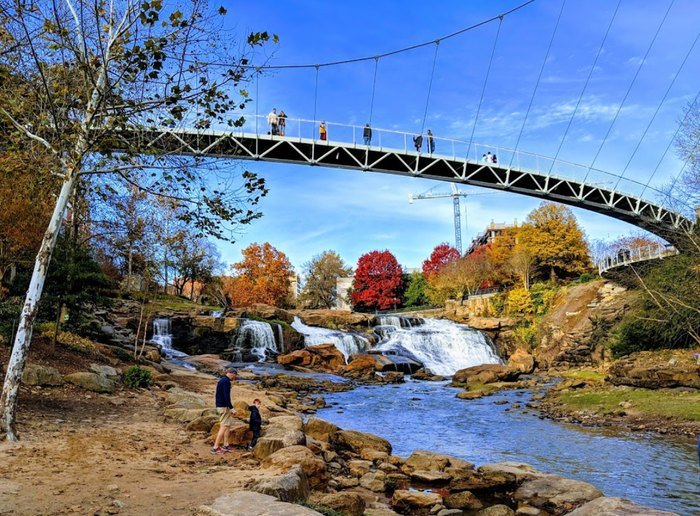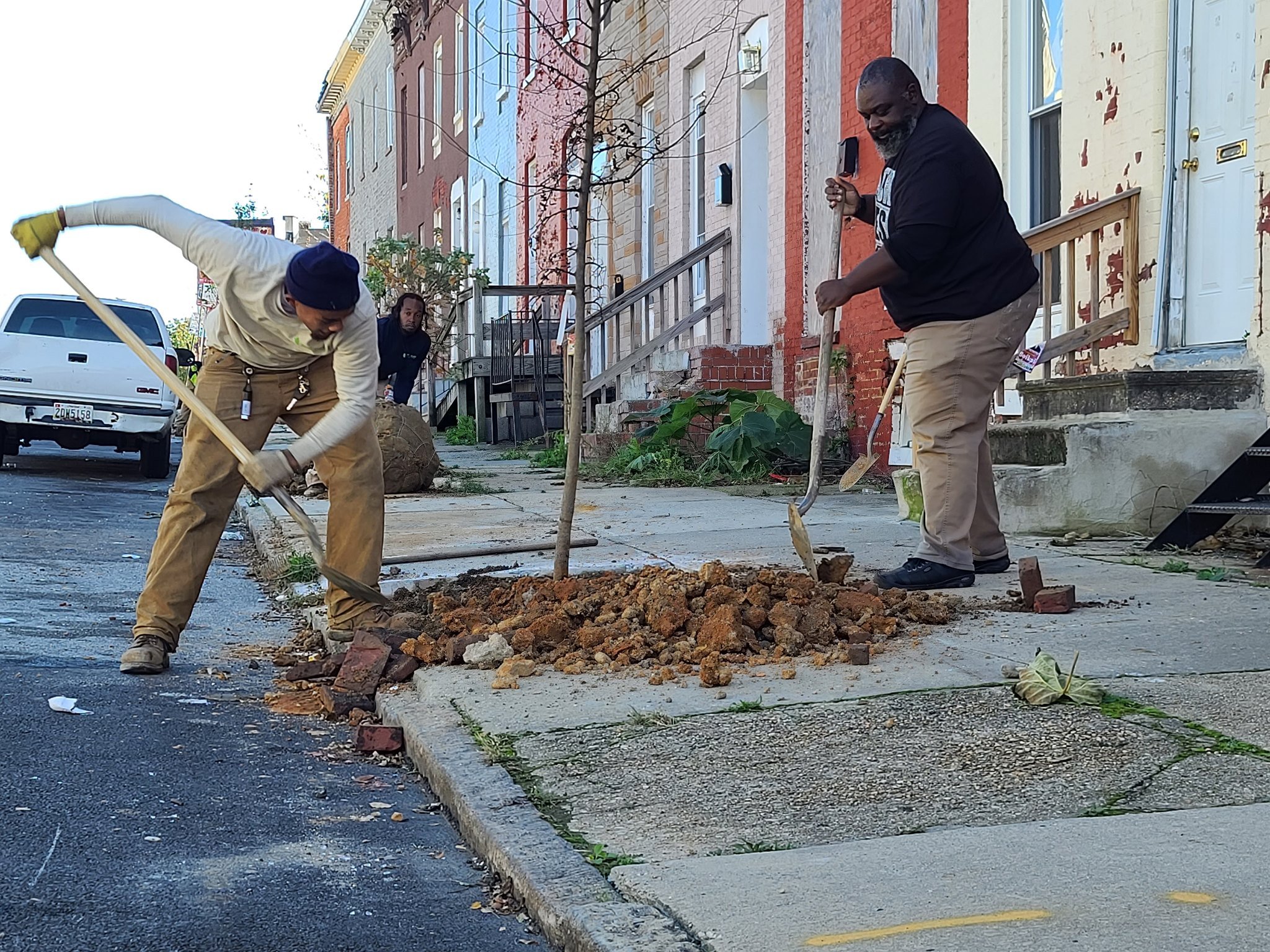KKB 4th Annual Summit: Urban Reconnection to Nature Recap
On November 10, Keep Knoxville Beautiful hosted our fourth annual Summit at the East Tennessee History Center. This year’s theme was Urban Reconnection to Nature, which showcased sustainable developments in three cities: Greenville, SC; Birmingham, AL; and Baltimore, MD. We heard firsthand from experts in the field about equitable and sustainable parks, tree equity, urban canopy, and the renewal of communities. If you weren’t able to make it to the Summit or if you attended and wanted to learn more, we’ve whipped up this handy recap so you can catch up on the main topics of discussion!
Falls Park on the Reedy. Photo by Only In Your State.
Mayor Knox White, Mayor of Greenville, South Carolina
Mayor White spoke about two major parks projects in Greenville, South Carolina. Anyone who has visited Greenville will have visited their signature landmark – Falls Park on the Reedy. But the park wasn’t always the bustling green space that it is today. In fact, for about a generation, no one in Greenville even knew there was a waterfall in the middle of their downtown. That is because a state highway was built over the waterfall in the 1960s, hiding the waterfall from public view.
In the 1980s, Carolina Foothills Garden Club president Harriet Wyche championed the idea of building a beautiful garden around the falls. She and Mayor White partnered together to see their vision come to life. At first, there was significant pushback at the prospect of removing the bridge. But when the design for the park was published on the Sunday newspaper, the visualization brought the park to life for many Greenville residents, who then became supportive of the plan.
In 2002, the bridge came down, and in 2004, Falls Park on the Reedy opened. The creation of the park revitalized the rest of the downtown, because it became a destination people wanted to visit. Mayor White shares that the lessons learned on this project include the importance of partnerships, people are visual, and find your champion. For the park’s champion Harriet Wyche, she lived to see her vision come to life with the opening the park.
Mayor White then spoke about another park, Unity Park. Unity Park was previously two segregated parks for black and white residents in the early 20th century. However, near the park were many of Greenville’s undesirable features, such as a landfill, jail, and police firing range. In 1938, the city decided to take this park, the only African-American park in the city, cut it in half, and build a baseball stadium there. Local leader Elias Holloway, the first black postal worker in Greenville, led a delegation to protest the building of the stadium. In response, the city promised to build a new park, which did not materialize.
When the city decided to create a new park on this land 75 years later, the community was cautious, remembering the unfulfilled promise of before. The city ripped up their plan for the park, and instead, listened to the community to see what their wants and needs were. They relied on community input to inform what amenities the park should possess. In May 2022, the park officially opened, fulfilling a promise 75 years in the making.
Pepper Place. Photo by Pepper Place.
Cathy Sloss Jones, Chair of the Urban Land Institute, Alabama Chapter, Birmingham, Alabama
Ms. Sloss Jones shared the importance of understanding and honoring history in Birmingham’s parks and green spaces. Birmingham was faced with a daunting question – how could the city face its horrific history and become a model or all cities? The answer came in not hiding from its dark history, but instead understanding and honoring it. The city has a world class Civil Rights Museum and monuments all over town. As Fred Shuttlesworth, Civil Rights leader and Birmingham resident always urged – think about the Birmingham that was, the Birmingham that is, and the Birmingham that can be.
For the Birmingham of today, that means maintaining the historic spaces and building green spaces around it. The construction of the railroad was incredibly important to Birmingham, as the city doesn’t have a river to transport goods. Now, since the railroad is not as widely used, the area was turned into a park. Another example is Pepper Place. Pepper Place was an old Dr. Pepper factory that was built during the Great Depression. Now the space is used for the local farmers’ market, bringing local produce to the Birmingham city center and bringing residents together to eat, dine, shop, and relax.
Ms. Sloss Jones advised the importance of looking to other cities and learning from them. There are opportunities to connect across the southeast, which will grow and improve all our cities.
Planting trees. Photo by Baltimore Tree Trust.
Ryan Alston, Communications and Outreach Manager for the Baltimore Tree Trust
Ms. Alston spoke about the importance to tree equity in Baltimore Tree Trust’s mission. Areas with lower income and racial minorities also have a lower amount of tree canopy, a sign of disinvestment in a community. Trees benefit health and the economy, but they also help cool temperatures. Urban heat islands are areas with excessive heat concentration as a result of lack of tree coverage and shade. These neighborhoods can be 12 to 15 degrees hotter than neighborhoods with trees. Baltimore Tree Trust believes in trees for all, that everyone should have access to green spaces.
Ms. Alston spoke on the tree equity score, which was developed by American Forests as a way to identify areas of high priority in terms of developing tree canopy. The areas in Baltimore with low tree canopy are a direct result of redlining practices in Baltimore. Neighborhoods that were deemed “unsafe” or “hazardous” had high numbers of people of color and other minority groups, and this redlining trickled down to determine the number of green spaces in a neighborhood. Baltimore Tree Trust works towards creating high levels of green spaces in areas with low tree equity score that have been historically disinvested.
Because of this, Ms. Alston spoke on the importance of receiving community input and providing education when planting trees in neighborhoods with low tree canopy. Baltimore Tree Trust educates residents on the benefits of trees, but also helps clear up misunderstanding about the impacts of trees, such as whether or not the planting of a tree will break up the sidewalk or if the roots will go directly into the pipes. Once they have completed their outreach, Baltimore Tree Trust works alongside the residents to plant and maintain the trees, making sure that they are a part of the conversation and work of making the community greener.
Since its founding in 2008, Baltimore Tree Trust has planted 16,000 trees in Baltimore city limits.
Ben Bentley (CEO of KCDC), Carol Evans (Executive Director of Legacy Parks), Kasey Krouse (Urban Forester of the City of Knoxville)
Mr. Bentley, Ms. Evans, and Mr. Krouse spoke about their organizations’ work with creating green and accessible spaces within Knoxville. Mr. Krouse spoke about the Tree Canopy Assessment that was completed in 2020, which revealed that 700 acres of tree canopy was lost acres inside city limits from 2008-2018. 500 acres of this loss occurred on single family residential property, which is a major question of the Tree Canopy Master Plan that is being developed by Trees Knoxville. They are looking to find a balance between development and keeping spaces green.
Urban Wilderness. Photo by Simply Awesome Trips.
Ms. Evans spoke on the importance of creating access to green spaces for all. Mr. Bentley spoke on the greenway system that is being developed in East Knoxville and other exciting projects in and around the East Knoxville community, such as the baseball stadium and the housing development First Creek at Austin. Mr. Krouse shared a rule popularized in Europe called the 3 30 300 rule for tree canopy access. From every window you should look out and see 3 trees, every neighborhood should have at least 30% tree cover, and wherever you are in a community, you should be within 300 meters of a green space.
Ms. Evans spoke on how Knoxville now sees itself as an outdoor town, which it hasn’t always. Knoxville has always had the Urban Wilderness, the Tennessee River, and our ridges and valleys; we just had to look up to see what we had. With the increased accessibility to these green spaces, Knoxville has a better sense of who we are.
Thank you to all our speakers, panelists, and attendees who made this year’s Summit a success!




